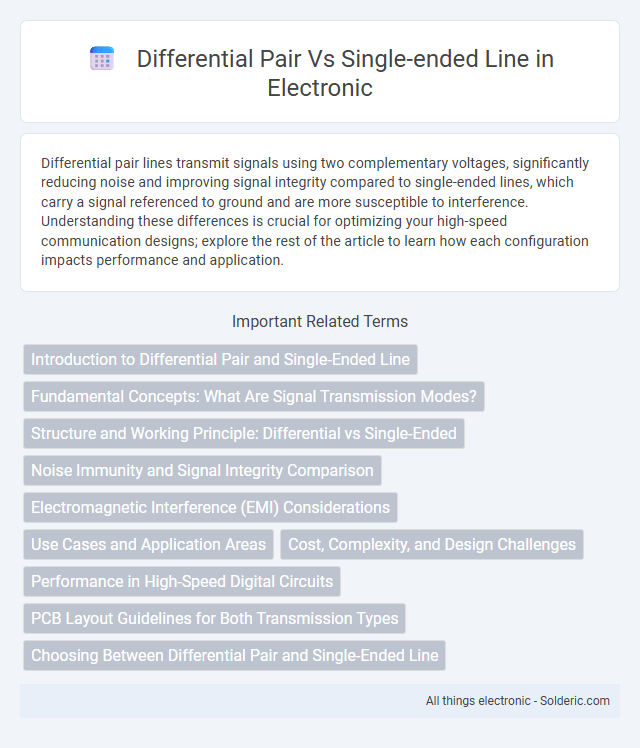Differential pair lines transmit signals using two complementary voltages, significantly reducing noise and improving signal integrity compared to single-ended lines, which carry a signal referenced to ground and are more susceptible to interference. Understanding these differences is crucial for optimizing your high-speed communication designs; explore the rest of the article to learn how each configuration impacts performance and application.
Comparison Table
| Aspect | Differential Pair | Single-Ended Line |
|---|---|---|
| Signal Transmission | Two complementary signals transmitted on paired lines | Single signal referenced to ground |
| Noise Immunity | High, due to common-mode noise rejection | Lower, more susceptible to noise and interference |
| Signal Integrity | Better, less signal degradation over distance | More prone to signal loss and distortion |
| EMI (Electromagnetic Interference) | Reduced EMI emissions | Higher EMI emissions |
| Cabling Complexity | Requires matched pair cables | Uses simpler single conductor cables |
| Cost | Higher due to cable and design complexity | Lower cost and simpler design |
| Typical Applications | High-speed data, USB, Ethernet, HDMI, PCIe | Audio, low-speed signaling, basic sensor lines |
Introduction to Differential Pair and Single-Ended Line
Differential pairs consist of two complementary signals transmitted on paired conductors, providing improved noise immunity and signal integrity compared to single-ended lines, which use a single conductor referenced to a common ground. Differential signaling reduces electromagnetic interference (EMI) and crosstalk by exploiting the noise-canceling effect between the opposite phases of the signals. Your system's performance can significantly benefit from understanding these key differences when designing high-speed or sensitive communication circuits.
Fundamental Concepts: What Are Signal Transmission Modes?
Signal transmission modes refer to the methods by which electrical signals travel through conductors, with single-ended lines transmitting signals via one conductor referenced to a common ground, and differential pairs using two conductors carrying equal and opposite signals. Differential pairs improve noise immunity and signal integrity by canceling out common-mode interference, making them ideal for high-speed or long-distance communication. Your choice between single-ended and differential signaling impacts the overall system performance, noise resilience, and electromagnetic compatibility.
Structure and Working Principle: Differential vs Single-Ended
Differential pairs consist of two complementary signal lines carrying equal and opposite signals, enabling noise immunity through signal cancellation at the receiver, whereas single-ended lines use a single signal conductor referenced to a common ground, making them more susceptible to external interference. The differential structure reduces electromagnetic interference (EMI) and crosstalk by balancing currents and minimizing loop area, while single-ended lines rely heavily on ground integrity to maintain signal fidelity. Differential signaling improves signal integrity at high frequencies by leveraging the difference between the two lines, unlike single-ended signaling that transmits voltage relative to ground.
Noise Immunity and Signal Integrity Comparison
Differential pairs offer superior noise immunity compared to single-ended lines by transmitting signals as opposite polarity voltages, allowing common-mode noise to be effectively canceled at the receiver. This arrangement enhances signal integrity, particularly in electrically noisy environments, by reducing electromagnetic interference (EMI) and crosstalk. Single-ended lines are more susceptible to noise and signal degradation since the reference ground can pick up interference, leading to lower reliability in high-speed or long-distance communication.
Electromagnetic Interference (EMI) Considerations
Differential pair transmission lines significantly reduce electromagnetic interference (EMI) due to their balanced signals, which produce opposing electromagnetic fields that cancel each other out, minimizing radiated noise. Single-ended lines, with unbalanced signals referencing a common ground, are more susceptible to both emitting and picking up EMI, leading to potential signal degradation. Careful impedance matching and routing are essential in differential pairs to maximize EMI immunity, whereas single-ended lines often require additional shielding and filtering to achieve comparable noise performance.
Use Cases and Application Areas
Differential pairs are commonly used in high-speed data communication, automotive networks, and audio equipment due to their superior noise immunity and signal integrity over long distances. Single-ended lines are favored in low-frequency, cost-sensitive applications such as simple sensor interfaces and consumer electronics where complexity and PCB real estate are minimized. Your choice between these depends on the required signal quality, environmental noise levels, and system design constraints.
Cost, Complexity, and Design Challenges
Differential pairs demand higher manufacturing costs due to the need for precise impedance control and matched trace lengths, increasing PCB complexity compared to single-ended lines. Designing differential pairs involves stricter layout rules to minimize noise and electromagnetic interference, which elevates design challenges. Single-ended lines offer simpler routing and lower cost but suffer from reduced noise immunity and signal integrity issues in high-speed applications.
Performance in High-Speed Digital Circuits
Differential pair transmission lines exhibit superior noise immunity and signal integrity compared to single-ended lines in high-speed digital circuits, enabling higher data rates with reduced electromagnetic interference (EMI). The balanced nature of differential signaling minimizes crosstalk and common-mode noise, improving timing accuracy and reducing bit error rates. Single-ended lines, while simpler and less costly, often face challenges with signal degradation and susceptibility to external noise at elevated frequencies.
PCB Layout Guidelines for Both Transmission Types
Differential pair PCB layout guidelines emphasize maintaining equal trace lengths, consistent spacing, and controlled impedance to minimize noise and crosstalk, ensuring signal integrity. Single-ended lines require careful impedance matching and proper termination to reduce reflections and signal degradation. Your PCB design should prioritize these practices to optimize high-speed signal transmission for both differential and single-ended configurations.
Choosing Between Differential Pair and Single-Ended Line
Choosing between differential pair and single-ended line depends primarily on noise immunity requirements and signal integrity. Differential pairs offer superior noise rejection and reduced electromagnetic interference (EMI) by transmitting complementary signals, making them ideal for high-speed and long-distance communication. Single-ended lines are simpler and cost-effective for short-distance, low-speed applications where noise susceptibility is less critical.
differential pair vs single-ended line Infographic

 solderic.com
solderic.com